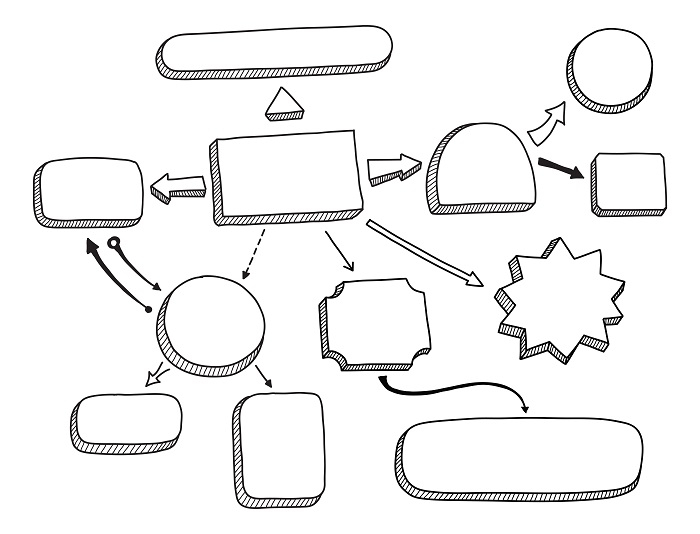
 Data Structure
Data Structure Networking
Networking RDBMS
RDBMS Operating System
Operating System Java
Java MS Excel
MS Excel iOS
iOS HTML
HTML CSS
CSS Android
Android Python
Python C Programming
C Programming C++
C++ C#
C# MongoDB
MongoDB MySQL
MySQL Javascript
Javascript PHP
PHPPhysics
Chemistry
Biology
Mathematics
English
Economics
Psychology
Social Studies
Fashion Studies
Legal Studies
- Selected Reading
- UPSC IAS Exams Notes
- Developer's Best Practices
- Questions and Answers
- Effective Resume Writing
- HR Interview Questions
- Computer Glossary
- Who is Who
Mind Mapping and its Importance
Mind mapping is a visual thinking tool that has become increasingly popular in recent years, as it has been proven to be an effective way to organize and structure thoughts and ideas. The process of mind mapping involves creating a central idea or concept and then branching it out with related thoughts and ideas.

This method of organization allows for a more holistic understanding of a topic and can also reveal new connections and associations. This technique is not just limited to students and professionals, but it's also suitable for personal development, problem-solving, and decision-making. In this article, we will explore the importance of mind mapping and how it can be used to increase creativity, productivity, memory, and collaboration.
What is Mind Mapping?
Mind mapping is a visual thinking tool that helps individuals organize and structure their thoughts and ideas. It is a powerful tool for brainstorming, problem-solving, and decision-making.
Mind maps can be used by students in school or at work—and they're even useful for anyone who wants to remember information better!
Benefits of Mind Mapping
One of the main benefits of mind mapping is its ability to increase creativity and productivity. By visually organizing ideas, mind mapping can help individuals overcome writer's block and generate new ideas. It also allows for the easy identification of patterns and connections, which can lead to more efficient problem-solving. Mind mapping can also be used for project management, helping individuals to break down large tasks into smaller, manageable steps.
Another benefit of mind mapping is its ability to improve memory and recall. By visually organizing information, mind mapping allows individuals to better remember and understand new information. This is particularly useful for students studying for exams or professionals preparing for presentations. The process of creating a mind map also aids in the retention of information as it requires actively engaging with the material.
Creating a Mind Map

Creating a mind map is a simple process that can be done using pen and paper or using mind mapping software. Here are the basic steps to creating a mind map −
Start with a central idea or concept − This is the main idea or topic that you want to explore in your mind map. Write it down in the center of a blank piece of paper or open a new mind map file in your software.
Add branches − From the central idea, add branches that connect to related thoughts and ideas. These branches can be labeled with keywords or short phrases.
Add sub-branches − As you continue to explore your ideas, you can add sub-branches that connect to more specific thoughts and ideas. These sub-branches can also be labeled with keywords or short phrases.
Add images or symbols − Mind maps can be enhanced by adding images or symbols that help to convey meaning. You can use symbols to represent different types of ideas, such as a lightbulb for an idea, or a question mark for something that needs further exploration.
Use color and formatting − Using different colors and formatting can help to distinguish different types of ideas and make the mind map more visually appealing.
Review and edit − Review the mind map and make any necessary edits. You can add new branches or sub-branches as needed and remove any ideas that are no longer relevant.
It's worth noting that creating a mind map is an iterative process, you can always come back and add more information or change the layout of the map as needed. Mind mapping is also a personal process, you can use the method that best suits you.
Effective Methods for Mind Mapping
Several effective methods for mind mapping can help individuals organize and structure their thoughts and ideas. Some of these methods include −
Radial Mind Mapping − This method involves creating a central idea or concept and then branching out with related thoughts and ideas in a radial pattern. This method allows for a more holistic understanding of a topic and can also reveal new connections and associations.
Linear Mind Mapping −This method involves creating a central idea or concept and then branching out with related thoughts and ideas in a linear pattern. This method is particularly useful for outlining and creating a linear structure for a project, essay, or presentation.
Concept Mapping − This method involves creating a central idea or concept and then branching out with related thoughts and ideas, but it also includes connecting the different concepts by lines and arrows, showing the relationship between the concepts. This method is particularly useful for understanding complex systems or ideas.
Tree-Structure Mind Mapping − This method involves creating a central idea or concept and then branching out with related thoughts and ideas in a tree-like structure. This method is particularly useful for understanding hierarchical relationships between ideas.
Schematic Mind Mapping − This method involves creating a central idea or concept and then branching out with related thoughts and ideas in a schematic format. This method is particularly useful for understanding technical or scientific concepts, as it allows for the inclusion of diagrams and images.
Personal Mind Mapping − Each person has their way of organizing their thoughts and ideas, and mind mapping can be tailored to individual preferences and needs, this type of mind mapping is particularly useful for personal development or self-reflection.
Importance of Mind Mapping
Mind mapping is an effective tool for learning, organizing, and problem-solving, as well as being more creative. It can be used to brainstorm ideas and solutions to problems, or simply help you get your thoughts out on paper. Some of the main importance of mind mapping include −
Increased creativity and productivity − Mind mapping allows individuals to organize and structure their thoughts and ideas visually, leading to increased creativity and productivity. By visually organizing ideas, mind mapping can help individuals overcome writer's block and generate new ideas. It also allows for the easy identification of patterns and connections, which can lead to more efficient problem-solving.
Improved memory and recall − By visually organizing information, mind mapping allows individuals to better remember and understand new information. This is particularly useful for students studying for exams or professionals preparing for presentations. The process of creating a mind map also aids in the retention of information as it requires actively engaging with the material.
Enhanced collaboration and communication − Mind mapping can also be used in team settings, as it allows for easy communication and collaboration. Team members can share their ideas and thoughts, and visualize the connections between them. This can lead to a more cohesive and productive team. Mind mapping can also be used to create a shared vision and goals for a team, leading to better alignment and understanding.
Conclusion
Mind mapping is a powerful tool that can help you become more productive. It can be used to learn new information and make sense of it, as well as to organize thoughts and ideas. It can also be used in team settings, allowing for easy communication and collaboration. With the availability of various software and tools, mind mapping has become increasingly accessible and can be used in various fields such as education, business, and personal development.

